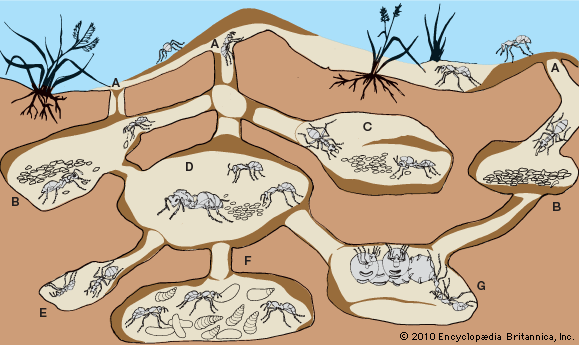Ant Colonies
Ant Colonies
Ants
are in the family Formicidae and there are around 12,000 species of ants in the world. Around 450 of those species can be found in North America. They can be
easily identified by their elbow shaped antennae. Ants live in a community that
is very structured and every ant has a role that they fulfill. The worker ants
are the ones in charge of building the colony. They do this by taking the dirt
out of the ground to form tunnels and chambers and they put the dirt outside.
This is how anthills are formed and these are what we see when we walk outside.
Every chamber that the worker ants make has a separate role. For example, some
chambers might be used for nurseries, others might be used for food storage,
and some might be used for mating. There has to first be a queen ant in order
to get worker ants. The queen ant is the beginning of an ant colony. The queen
mates with a male ant and then raises her first round of ants in a nest. Before
mating with the male ant the queen had wings, but after mating the queen loses
her wings. She then feeds her wings to her young for food. When the worker ants
are old enough they start to do their roles in the colony. Some of the jobs
that they do are make the nest larger, take care of the baby ants, and bring
the queen ant food so she can focus on laying more eggs. After the queen has
produced more worker ants, then they start to have more specialized jobs. Some
ants might specifically work on making their colony bigger, while some just
focus on taking care of the larvae and bringing the queen food. When the colony
is big enough then the queen will start to produce other queens. The new queen
ants are taken care of until they are old enough to go make their own colonies.
The size of the ant colonies is dependent on the species so it can vary widely.
The queen ant is important to the colony so if the queen dies for some reason
then no more ants can be produced and the colony will die off eventually. Some
species of ants have more than one queen, so the worker ants will work together
to kill off all of the queens until only one queen is left. However, in some
cases they go too far and kill off all of the queens. This will end up killing
the colony because there will be no more queens to make any more ants. There
are only two types of ants that have wings. The queen ants and male ants both
have wings and for the same purpose. They have wings in order to fly and find a
mate. Male ants are only produced by queen ants at specific times. Male ants
are a product of unfertilized eggs. The male ants have only one purpose and
that is to mate with the queens. After the male ants mate they usually die soon
after. Some species of ants have army ants. Army ants are in charge of
protecting the colony. Their bodies have a slightly different structure because
of this. For one, their head is slightly larger than the worker ants in order
to provide them with more protection while they defend the colony from threats.
Their structure allows for them to better defend the colony. Overall, each ant
has their own job. All of the jobs help the colony to keep functioning like it
should.
https://invbrain.neuroinf.jp/modules/htmldocs/IVBPF/Ant/Ant_brain.html
https://kids.britannica.com/students/assembly/view/144467
References
Ant species of the world. AntKeepers. (n.d.). https://antkeepers.com/pages/ant-species-of-the-world
Intagliata, C., McNamee, K., Chang, A., & Shapiro, A. (2023, November 14). How army ants’ architecture demonstrates their collective intelligence. NPR. https://www.npr.org/2023/11/14/1213008636/how-army-ants-architecture-demonstrates-their-collective-intelligence
Sanders, A. (2019, November 22). How does an ant colony operate?. Sciencing. https://sciencing.com/ant-colony-operate-4728516.html




Nice work! I love how informative and to the point this blog post is. It makes it easier to understand how an ant colony can function together.
ReplyDelete